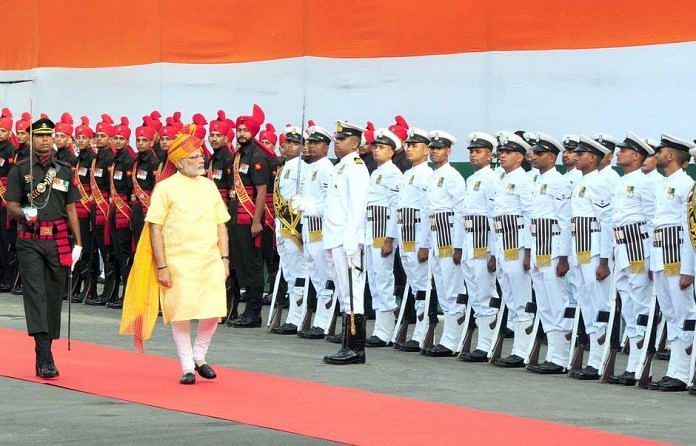There is an unconventional makeover of parliamentary democracy underway in India with PM-President Narendra Modi.
Is Prime Minister Narendra Modi becoming more presidential? Three years into his five-year term is a good point to evaluate this transformation. Modi has arguably become India’s first Prime Minister-President, a new hybrid political creature. He is in a ‘permanent election’ mode, and has converted 543 Lok Sabha constituencies into one national (nationalist) constituency.
Consider Modi government’s two most important decisions: surgical strikes and demonetisation. They are examples of momentous, non-legislative unilateral executive orders. They were carried out by a select, trusted bureaucratic team of advisors in a shroud of secrecy and surprise – the leitmotif of his leadership style.
Many neutral observers say that both these decisions were poorly executed and failed to achieve the stated policy objectives. But who cares? President-Prime Minister Modi won popular support for his moves, winning a landslide victory in the crucial elections in Uttar Pradesh. Supporters of demonetisation also presented Modi as the new-age guru of the dispossessed and disaffected masses.
The PM is no longer a passive policy maker or a legislative deal-maker in the parliament. He is chief-campaigner for his party and chief-spokesperson for the government. The moral and political restraints of classic democratic politics are erased here. Though the original design of parliamentary system remains intact, the nature of prime ministerial politics has changed beyond recognition in India. Democracies are a unique architecture of ‘separated institutions sharing powers’.
Conventional wisdom suggests that prime ministers rule with legislative authority and presidents govern with executive orders. Most presidents also exercise rhetorical ‘power to persuade’, to lead the nation. Thus, presidential mode of governance offers a very tantalising option. No guessing why strong, powerful and charismatic presidents are more popular than prime ministers. This unconventional makeover of parliamentary democracy in India has bamboozled many including the likes of Shashi Tharoor who recently batted for presidential form of governance in India.
Suffused with the Nietzschean Will-to-Power, Modi does not bother about the cacophony of hoots, cackles and wails in legislative debates. In a typical presidential style, he prefers to talk outside the discursive and argumentative space of parliament. That’s why his monthly ‘Mann Ki Baat’ radio shows are popular with the neo-middle classes. Prime ministerial-presidency is not just rhetorical showbiz.
It is visible in other areas of governance and governmentality such as reorganising ministries, administrative departments and regulatory processes, and determining how legislation is implemented and appointments of ministers and allocation of their work. The induction of retired bureaucrats in the recent cabinet reshuffle is another instance of a trend of growing reliance of the PM-presidency on professionals and experts. In short, the PM-president needs neither demos (Greek word for people) nor politics in the conventional sense.
Much of this stealthy transformation of the parliamentary system has been caused by the ‘personality of personalizer’ Prime Minister Modi. However, long-term institutional factors have also contributed to the political infrastructure for PM Presidency. The fabled Nehruvian golden age of parliamentary democracy is passé. While parliament has become more representative, it has declined in status and effectiveness. Debates in the parliament have become a farce due to low number of sittings and frequent disruptions with comatose legislative activity.
Most political parties are family-controlled mom and pop stores mired in caste, corruption and crime. Elections have increasingly become the haven of black money. Worse, successions of coalition and minority governments at the centre since 1989 have further damaged the effectiveness of parliamentary governance. No wonder, courts have become the ultimate arbiter of policy conflicts. Cumulatively, these factors have a perverse impact on Prime Ministerial system.
But the ‘permanent campaigning’ by 24/7 electronic media and social media (paid or unpaid) has been the most decisive force multiplier behind this new PM-presidency in India. The blending of the communication revolution with the extensive public addresses, symbolic appeals, image formulation, pulse-taking, and frequent travel across by ‘the great leader’ seem to have changed the nature of conventional politicking in the parliamentary system.
In this kind of quasi-presidential, quasi-parliamentary politics, parties have been reduced to merely acting as mobilising machines. And baby-faced millennial techies, ad men and spin-doctors have turned elections into a dot.com industry. Remember, the messiness and complexities of politics are being increasingly resolved in the virtual chambers of social media especially on the pages of Facebook, Twitter and WhatsApp.
All this sounds honky-dory for now. However, expect severe social and political consequences soon. Given the competitive multi-party electoral system, the increasing zero-sum game in the PM-presidency has raised the stakes for winners and losers leading to classic fears of majoritarianism of various sorts in India. Since the days of Aristotle we are aware that the ambition of great leaders is threatened by the ambitions of second-rank leaders. So “must crimes be punish’d but by other crimes”, to quote the British poet Lord Byron.
Also read: Red tape be damned, Modi is creating a new bureaucracy tailored to his vision
Ashwani Kumar is a poet, author and Professor of Development Studies at Tata Institute of Social Sciences (Mumbai). He is also a Senior Fellow at the Indian Council of Social Science Research. His recent book is titled “Banaras and the Other”, first of a trilogy on religious cities in India.



